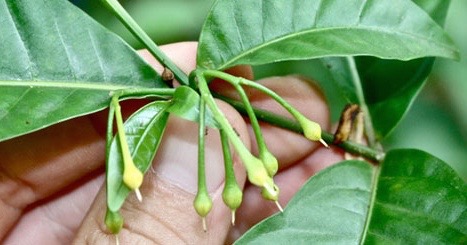Over the past year reliable information has surfaced suggesting that Tabernanthe iboga may be disappearing from its natural habitat in the Central West African rainforest. Iboga is the most prolific source of ibogaine, an alkaloid that has been used since the 1980s as an experimental treatment for substance use disorders. However, despite information about its sustainability many ibogaine therapy providers continue to use iboga and iboga extracts of unknown origins. This conflicts with the Nagoya Protocol, an international treaty aimed at protecting biodiversity and indigenous rights. This is despite the fact that there are perfectly sustainable and economically viable alternatives that don’t involve the harvesting of wild plants.
For the past several years I have been serving as the Executive Director of the Global Ibogaine Therapy Alliance (GITA), a not-for-profit dedicated to supporting the sacramental and therapeutic uses of iboga. I summarized the information about the reported threat to iboga’s sustainability in an article last March, and also facilitated the translation of a Gabonese television program examining the situation. Prior to that I organized an international conference in South Africa that resulted in the summary of a report by Yann Guignon, a French ecological consultant deeply connected to the traditional use of iboga in Gabon. Over that time I have continued to dialogue with many people who buy, sell and administer iboga and ibogaine, as well as iboga seeds. This information has obviously struck a chord with many, but changes are still noticeably slow. As the situation continues uninhibited, I believe it is important to draw even further public awareness around it and advocate for a more coordinated effort.
The details of this situation have already been outlined in the works mentioned above. Here, I want to focus on first summarizing some basic recommendations for sustainable iboga use today, and then taking some initial steps towards a broader discourse about why this guidance is important to consider.
First, for anyone who is looking for ibogaine therapy, or anyone who is providing it, there are some basic ways to ensure that your current use is sustainable:
- Use ibogaine that is produced from Voacanga africanis or another alternative source. This is the simplest and most obvious solution. If you are looking for an ibogaine therapy provider, simply ask them if they exclusively use medicine that is produced from voacanga. This plant is grown agriculturally elsewhere in Africa and is completely renewable. Ibogaine can be produced semi-synthetically from its primary alkaloid, voacangine. If you follow this and only this recommendation, then you’re doing due diligence and working ethically and sustainably toward the environment and indigenous rights.
- However, if you are purchasing any iboga tree products, whether it is root bark or seeds, for your plantation, you must ask for legally recognizable documentation proving its non-Gabonese origin. It should be easy for a provider to demonstrate this if they have it. Verbal confirmation and photographs of plants growing outdoors are not definitive. Documentation needs to be provided by an agricultural authority in the country of origin, and needs to specifically identify the package of material that you’re receiving. Without this you are likely breaking the Nagoya protocol, which means that you or any other commercial providers who you resell to in the future may be prosecuted under its terms in the future. Also, without this you have no other way to ensure that the material you’re using hasn’t been poached.
- As a further concern, even properly documented non-Gabonese iboga, if it is taken from the wild rather than cultivated, is unsustainably harvested. In order to be realistically sustainable any Tabernanthe iboga that you use should come from a plantation; otherwise, because of the levels of current demand, it’s contributing to the reduction in wild supply, as well as important biodiversity.
This is quite easy to follow, but it outlines some major limitations on the medicines that are currently viable, which might seem tedious or highly bureaucratic to some. While there is currently easy access to sustainably produce purified extracts, a lot of providers prefer to use full spectrum extracts or root bark. It’s true that they have a different set of benefits. However, these benefits just simply do not justify the potential social and ecological costs.
Many people have chosen to ignore this situation altogether. Occidental culture is deeply troubled by an overwhelming and indefensible sense of entitlement to natural resources. Of course, the treasures of the Earth are here for us to share, but it’s important to understand that they need to be protected and cultivated, otherwise rather than being shared they are simply being pillaged. Even those who are comfortable criticizing goliath corporations or governments for their obvious environmental or social justice abuses are willing to ignore personal responsibility when they are engaged in the exact same type of destructive behavior for something which they deem to be spiritual or personally meaningful, especially if its connected with an economic opportunity.
It’s important that we investigate these beliefs in order to understand how our personal philosophies guide our actions and how to choose the most beneficial of all possible outcomes. Otherwise we are unable to ensure that these plants are available for future generations, especially in their native habitats.
Iboga rests at an interesting intersection between ancient African spiritual practice and cutting edge allopathic medicine. Its use spans all of human history, and presently, the entire globe. It is deeply effected by some of the most relevant geopolitical issues defining our time, including the war on drugs and the ecological crisis. In order to fully understand the threat to iboga’s sustainability, we need to make some broad strokes and look in particular at the ecological context that surrounds it.
August 13th, 2015 was recognized by the Ecological Footprint Network as Earth Overshoot Day. This marks the threshold when our consumption of natural resources for the year superseded the Earth’s capacity to renew those same resources. That doesn’t even include the needs of other living species. What this illustrates is that for the rest of the year we are essentially running an ecological deficit, and that we would need 1.6 Earths in order to sustain civilization as it operates today. Of course, we only have one.
There is overwhelming consensus in the scientific community that high levels of material consumption, the net increase of greenhouse gases, and other human activity is leading to long term and systemic impacts on the climate. Scientists say we are currently in the midst of the sixth great mass extinction in the Earth’s history, but for the first time this is being caused by our own efforts. We have accelerated the background rate of species extinction by 1,000 to 10,000 times and by the middle of the century, scientists estimate that we will have caused the permanent loss of 30% to 50% of all living species.
This is not a problem that is larger than us, but one for which we are directly responsible, and which is reversible with effective changes. In the case of iboga, as in many of the other micro-dynamics affecting individual ecosystems, there is overwhelming evidence that our actions are actively contributing to this effect. This is even more disturbing considering that there are viable alternatives that are easily within our grasp. Turning a blind eye to this will make us party to an extremely disappointing future.
Treating addiction requires a working understanding of what it actually is. Despite broad discourse on its very complex causes, it’s relatively easy for most people to accept that what we talk about as addiction can be defined as continuing to engage in an activity despite the evidence of negative consequences.
By participating in the export economy of iboga root bark and T. iboga based extracts without ensuring that they are coming from viable plantations, we have done nothing except to find some personal gain by exporting the negative consequences of our addictions to the “dark continent.”
It is critical that those who want to use iboga root bark and full-spectrum alkaloids with respect for social justice and indigenous rights invest in alternative technologies or in plantations. As an important keystone rainforest species, iboga provides a huge potential in the design of forest gardens. It requires shade, which can be provided by fruit trees, productive canopy crops, or vines.
Even though I think that forest garden designs would provide a beautiful model for the healing clinics of the future, I’m simply suggesting that anyone working with iboga take a cautious look at the social and environmental context of the plant and how their actions affect it. As healers it’s important that we do not simply continue the conventional human practice of trading in the environment for greed and convenience. There are clear and economically viable alternatives available, and no reason whatsoever why this shouldn’t be a quick and complete transition.











